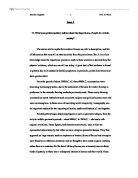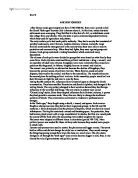What became known as ‘orientalising’ styles spread across from the East, with such art being found in places like Corinth and Crete. The Geometric, black and white style of Dark Age pottery declined, giving way to new designs and styles. The Myceneaens were known to be skilled artists, a different style perhaps did not mean progress, but in the eyes of contemporary standards, it was a significant advance.
There were also some signs of progress in agriculture, with iron now being used in the production of farming tools. There was also a shift from pastoral to the more sustainable arable farming and the increasing presence of granaries suggests this as well.
The Olympic Games started in around 776 as a fairly localised event but soon became pan-Hellenic. Other games appeared elsewhere, at Isthmia, Nemia and Delphi. It encouraged both unity and more healthy rivalry in Greece during the Archaic Age. Military tactics changed. While in the Mycenaean and Dark Age Greece the somewhat primitive army was headed by an aristocrat, the Archaic period saw the development of Hoplite fighting. It is unknown as to how this development came into existence, but it did initiate a change socially, the gradual decline of aristocracy as a powerful group.
In Mycenaean and Dark Age Greece, aristocracy was a key part to society. Governments consisted of the King or head of an aristocratic family, and they exercised considerable authority: they were law-givers, commanders, judges and jury. The Mycenaean palaces were a testament to their power and their prestige, this pattern can be seen throughout the Dark Age. Both Homer and Hesiod recognised that the hierarchy existed. The former acknowledged this indirectly in the well-known example of Thersites’ objection to Agamemnon over the siege of Troy, and Achilles’ subsequent put-down: ‘sit still and wait for orders from your betters, you are no warrior and a weakling, counting for nothing in battle or debate’. Hesiod laments the absolute power of the aristocrat in ‘Work and Days’, likening him to ‘a stronger bird’ and ‘what he will he’ll do’. With the arrival of the Archaic Age came change, due to a number of factors, which as developments in their own right have been discussed earlier in this essay, the first of which was colonisation.
A colonist, who had formally been under control of an aristocrat, would have needed a certain amount of initiative. With the arrival of new found independence of life possibly came the independence of thought, and the idea of an aristocrat-based society would be out of date in their new territories. A high-ranking noble would be very unlikely to risk his position at home, for the relative high risk of pastures new, so the many new communities founded around this period by the lower classes would not be ruled by an elite force. By setting up a home in other areas one would also be brought into contact with other societies, perhaps more equal societies, of which ideas would inevitably filter through to newcomers. Starting a community from afresh would often mean new approaches, alternative ideas from the Dark and Mycenaean Ages.
The new wealth that Greece was enjoying would make some of the beneficiaries less dependent on the aristocracy, thus enabling them to afford military equipment for their sons, whose role in the fairly new hoplite army would diminish the aristocracy’s military superiority. As can be seen throughout history, once this ‘ingrained idea’ of natural superiority is questioned or threatened by an emerging ‘middle class’, the seeds are sewn for social change however gradual this growth may be.
All this contributed to the decline of aristocracy as a political force, opening the route for the emergence of a new kind of political system based on equality. Of course the aristocracy continued to enjoy privilege and power throughout Archaic Greece. Places in high office were restricted to those who owned sizable assets and property, the aristocrat remained in authority but the principle was different, they were answerable to the people. They also remained as a socially exclusive elite for many years, so it was in their power and influence more so than their lifestyle and wealth that one can see the decline during the Archaic Age.
The turbulent years of changing rule in Athens, compared with the relatively stable Sparta whose aristocracy continued to dominate, proved that power ceased to be monopolised by a single family or group, and that politics had been opened up to many more people.
Fundamentally linked with the decline of the aristocracy was the emergence of Greek democracy. Although it took many different forms in the early years, Forrest argues that ‘the opening of the Greek mind is much more important than the particular forms of government which were produced by the opening’. As has been previously discussed, new ideas, ‘compulsory originality’ as Finley puts it, began to create a very different society from that of the two ages that preceded it. By the end of the Archaic period, a political sophistication had been shown by the city-states of Greece, significant progress that cannot be underestimated.
An ideological shift had occurred, but it was necessary for it to be translated into something more lasting, into written law. Mycenaean and Dark Age Greece did not have laws as such, the ‘commoner’ accepted that life was the way it was and never questioned why. With the invention of the Greek alphabet, it was now possible to place a code on existing laws and introduce new ones as well. Attica provides us with the best example of this in Athens. In 594, following internal problems, Solon was elected Law-Giver of Athens, and begun the codification of laws, many of which had been in practice for some time, while introducing measures that would also promote equality. Citizens were to be equal in the eyes of the law, all debts were to be cancelled to release many Athenians from virtual enslavement to their creditors, and the power of the citizens assembly was to equal that of Aeropagus, the aristocratic dominated community that had ruled previously. The nobles had been ‘servants of the state’, rather than absolute rulers. The poor had rights, and were recognised as citizens of Athens. The citizen assembly became the highest court of appeal. These are but a few of the many measures that demonstrated the progress that Athens had made, and most city-states followed this basic idea through the period.
There were still inequalities, high offices were limited to certain citizens only, and women were not allowed to represent themselves in court or involve themselves in politics. Oswyn Murray argues that the position of women actually declined from the earlier ages as life became more urbanised. Slavery was still in existence for non-Athenians, but this was still significant progress at this point.
Even in Sparta, where the aristocracy continued to dominate, there was at least as Forrest puts it a ‘basic minimum’ that was applied by Lycurgus in the early Archaic Age, which remained virtually untouched for centuries. Spartiates were guaranteed some sort of political quality, and he set up Sparta’s renowned military program. This was great progress by contemporary standards, the ‘homoioi’ themselves realised this, and especially as Athens’ changes came a century later.
Athens and Sparta stand out as important examples of progress in the Archaic Age; nevertheless the former was representative of most of Greece during this time, while Sparta was the exception to this general trend.
The Archaic period in Greece, as we have seen, saw the transition from tyrannical rule to republic and it is arguable that a possible catalyst of this was the ‘tyrannos’. Although later associated with being the exact opposite of the ‘polis’, the role of the tyrants may well have been to contribute to this process. A tyrant had to placate the masses, to please possible rivals whilst at the same time maintaining the imbalance of power in his favour. It is possible to say, that abroad he would have sought peace in order to consolidate himself at home, if he succeeded in this, he would provide stability and continuity, in particularly if he managed to create a dynasty for his family. The best example of this offered, once again by Athens, where Pisistratus upheld Solon’s laws and eventually became quite popular and thus secured his dynasty. Where the tyrant was not so popular he was deposed, as shown by the expulsion of his sons who were to succeed him. It was never quite this simple, but it is possible to say that when tyrants fell, the people became more aware of their political power and were unlikely to tolerate another ‘tyrannos’ and quite possibly promote the idea of the ‘polis’. A generalisation as this may be, but as Forrest puts it ‘common to all the most flexible societies is turmoil and common to all is the achievement in the end of some sort of what we are prepared to describe as the constitutional government of the city-state, a city state made up of a defined body, occupying a defined area, living under a defined or definable constitution’.
Contact with the East, and with its development in trade, the recovery of writing constituted major progress by the Archaic Greeks. Greek society became more civilised during the Archaic period through the ideas of equality and justice which were then transferred into law in order to create the constitution. Although all communities developed at different rates, sometimes with difficulty, the city-state at the end of the Archaic period showed progress from the previous two ages.
Bibliography
Ancient Sources
Herodotus, The Histories, Trans. Robin Waterfield with introduction and notes by C. Dewald (Oxford, 1998)
Homer, The Odyssey, Trans. E.V. Rieu revised by D.C.H. Rieu in consultation with Dr P.V. Jones (Penguin Books, 1991)
Homer, The Iliad, Trans. Martin Hammond (Penguin Books 1987)
Modern Authorities
Boardman, J., Griffin, J., Murray, O. (1986), ‘The Oxford History of the Classical World’ (Oxford University Press)
Bury, J.B., Meiggs, R., (1975), ‘A History of Greece’ 4th ed. (Macmillan Education, London)
Finley, M.I., (1991), ‘The Ancient Greeks’ 2nd ed. (Penguin)
Boardman, J., Griffin, J., Murray, O., (edd.) (2001) ‘Oxford History of Greece and the Hellenistic World’ (Oxford University Press)
Forrest W.G, (1966) ‘The Emergence of Greek Democracy’ (World University Library)
Murray, O. (1993), ‘Early Greece’ 2nd ed. (Fontana History of the Ancient World)
Hornblower, S., Spawforth, A., (edd.) (1993) ‘The Oxford Classical Dictionary’ 3rd ed. (Oxford)
p.88, ‘The Emergence of Greek Democracy’, Forrest
p.41, ‘The Ancient Greeks’, Finley
p.44, ‘The Ancient Greeks’, Finley
p.23, ‘Oxford History of Greece and the Hellenistic World’, Forrest
p.21 ‘The Oxford History…’, Forrest







